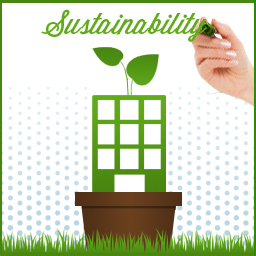4 Steps to Developing a Sustainability Plan For Facilities
 In today's market place, it's easy for organizations to lose sight of sustainability in lieu of cost cutting and trying to do more with less. The fact is, sustainable practices CAN save organizations money while preserving our environment for future generations.
In today's market place, it's easy for organizations to lose sight of sustainability in lieu of cost cutting and trying to do more with less. The fact is, sustainable practices CAN save organizations money while preserving our environment for future generations.
Facility maintenance departments have opportunities to make real differences by being champions for sustainable work environments. Much can be done with today's facilities to reduce the environmental impact and have a positive effect on maintenance budgets.
The first step is to develop a plan for sustainability that will out line your goals and include a plan for implementation. Gogreenplus.org has a simple eight step outline for developing your first plan. The following is the outline shortened to four steps and re-purposed for green conscious facility managers.
Step 1: DEFINE YOUR MISSION
Your mission should be clear and concise outlining your purpose, your commitment, and your actionable initiatives. Here is an example mission statement.
"As a facility maintenance department, we are tasked with ensuring the sustainability of our built environments. Our continual commitment will be to accomplish our primary tasks using proven sustainable approaches that limit adverse effects on the environment. These approaches will include implementing sustainable facility energy solutions, purchasing environmentally safe/renewable consumables, properly recycling failed parts/equipment, and utilizing automated systems to manage our maintenance operation."
Step 2: RESEARCH VIABLE OPTIONS FOR YOUR INITIATIVES
The first part of your research requires pulling together statistics about your current operation regarding waste, toxic emissions, and energy usage. This helps to determine if there will be enough savings and environmental impact reduction to justify the initial costs of your sustainability projects. Once you have a benchmark set, you can now create goals for where you want to be in 5, 10, even 25 years.
Next, research options for meeting your goals. Here's an example:
Referring to the sustainable facility energy solutions initiative stated in our mission statement, two phases could be defined. The first phase could involve reducing wasted energy consumption throughout the facility. This can be accomplished by taking advantage of smart building and smart grid technologies, upgrading to energy sipping LED lighting, or any one of a myriad of energy saving practices that can be indoctrinated during day to day operations. Reducing energy usage is always a good investment, and will have the quickest payback.
The second phase could include taking control of the type of energy being supplied to the facility. It may be feasible to integrate sustainable energy sources such as wind, solar, and hydro power. You'll want to look into sustainable energy projects after reducing consumption in phase one. This ensures renewable power generation is optimally sized for the facilities consumption level. Also, look for an energy supplier that incorporates sustainable technologies and is proactive about reducing carbon emissions.
If this part of the process seems a little daunting, there are firms that will benchmark and find viable energy efficiency measures for you, such as our parent company C&S Companies.
Step 3: CREATE TIMELINES FOR ACCOMPLISHING EACH INITIATIVE
When forming smart goals, you need to have a time-frame for completing them or they will get lost by the wayside. Start with initiatives that are easy to implement, less costly, and require less time to complete. Researching new consumable vendors, and switching to one that offers green alternatives is a good example. Look for products that are manufactured using environmentally friendly processes, offer higher biodegradability, and use recycled materials. Here is a good article on choosing green industrial lubricants.
Pair better performing green lubricants with condition based oil changes and you have a great recipe for creating an environmentally conscious maintenance department. Within a few minutes you will have already jump started your campaign. Other longer initiatives may require a Gantt chart to schedule out your implementation plan.
Step 4: REVIEW, ANALYZE, AND CHANGE THE PLAN AS NECESSARY
Always keep in mind your mission statement when reviewing your sustainability success. If you have set hard goals such as reducing the amount of paper consumed to process work orders by 50%, make sure you are actually meeting those goals. One or many parts of your implementation plan can fail, and you have to be ready to troubleshoot and make changes.
Regarding the paper use reduction initiative, you may have decided to adopt a web-based maintenance software package to eliminate the paper trail associated with your current process. It sounds great in theory, but it's hardly ever that easy when you go to implement. Adopting new maintenance software can be hard for some individuals who are used to walking around with a stack of work orders.
To troubleshoot this issue, add an education piece to your plan to help employees learn and understand the new software and why it's necessary to meeting your sustainability goals. After, you should notice that they are more comfortable with letting go of their old habits.
For more on facility sustainability planning, the International Facility Management
Association (IFMA) is offering a seminar that goes in depth about starting a sustainability initiative, Link to Seminar.
Ryan Noble
Ryan is Q Ware's Marketing Specialist.